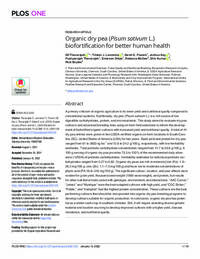Organic dry pea (Pisum sativum L.) biofortification for better human health

Authors:
A primary criticism of organic agriculture is its lower yield and nutritional quality compared to conventional systems. Nutritionally, dry pea (Pisum sativum L.) is a rich source of low digestible carbohydrates, protein, and micronutrients. This study aimed to evaluate dry pea cultivars and advanced breeding lines using on-farm field selections to inform the development of biofortified organic cultivars with increased yield and nutritional quality. A total of 44 dry pea entries were grown in two USDA-certified organic on-farm locations in South Carolina (SC), United States of America (USA) for two years. Seed yield and protein for dry pea ranged from 61 to 3833 kg ha-1 and 12.6 to 34.2 g/100 g, respectively, with low heritability estimates. Total prebiotic carbohydrate concentration ranged from 14.7 to 26.6 g/100 g. A 100-g serving of organic dry pea provides 73.5 to 133% of the recommended daily allowance (%RDA) of prebiotic carbohydrates. Heritability estimates for individual prebiotic carbohydrates ranged from 0.27 to 0.82. Organic dry peas are rich in minerals [iron (Fe): 1.9–26.2 mg/100 g; zinc (Zn): 1.1–7.5 mg/100 g] and have low to moderate concentrations of phytic acid (PA:18.8–516 mg/100 g). The significant cultivar, location, and year effects were evident for grain yield, thousand seed weight (1000-seed weight), and protein, but results for other nutritional traits varied with genotype, environment, and interactions. “AAC Carver,” “Jetset,” and “Mystique” were the best-adapted cultivars with high yield, and “CDC Striker,” “Fiddle,” and “Hampton” had the highest protein concentration. These cultivars are the best performing cultivars that should be incorporated into organic dry pea breeding programs to develop cultivars suitable for organic production. In conclusion, organic dry pea has potential as a winter cash crop in southern climates. Still, it will require selecting diverse genetic material and location sourcing to develop improved cultivars with a higher yield, disease resistance, and nutritional quality.
